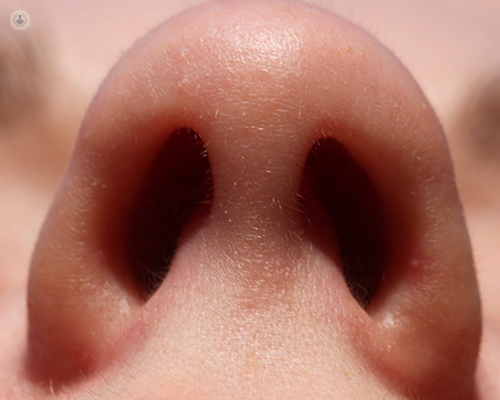Turbinate hypertrophy
Mr Kwamena Amonoo-Kuofi - Otolaryngology / ENT
Created on: 06-14-2016
Updated on: 03-24-2023
Edited by: Aoife Maguire
What is turbinate hypertrophy?
Turbinate hypertrophy is a condition affecting the respiratory mucosa. The turbinates, also known as nasal conchae, is a part of the nasal fossa. They are six narrow, curled shelves of bone and connective tissue covered by a mucosa that protrude into the breathing passage of the nose. The turbinates ensure that the air passing through the nose is heated up and humidified. Sometimes they can become inflamed and increase in size. This is what happens when you have turbinate hypertrophy.
What are the symptoms of turbinate hypertrophy?
Turbinate hypertrophy can cause the following symptoms:
- A sensation of blocked, obstructed nose;
- Trouble breathing;
- Headache;
- Secretion of mucus from the nose into your throat;
- Sinusitis;
- Snoring;
- Dry, tickly cough;
- Dry mouth;
- Impaired sense of smell;
- Bad breath;
- Itchy nose;
- Sleep apnoea;
- Pain at the base of your nose;
- Sneezing;
- Nosebleeds (epistaxis);
- Nasal or metallic sounding voice (rhinolalia);
- Hearing loss (hypacousia);
- A muffled sensation in your ears
How is turbinate hypertrophy diagnosed?
To confirm a diagnosis of turbinates hypertrophy, you’ll need to go through your medical history with your doctor and do the following exams:
- Rhinofibrolaryngoscopy;
- Nasal cytology;
- Rhinomanometry;
- Allergy testing
What causes turbinate hypertrophy?
Some risk factors that may lead to turbinate hypertrophy are:
- Seasonal or perennial allergic rhinitis
- Non-allergic or vasomotor rhinitis
- A change in temperature or humidity
- Taking certain medications or being on hormone therapy
- Frequently recurring common cold
- Exposure to certain chemicals
- Smoking
- Emotional stress
How is turbinate hypertrophy treated?
The treatments largely depend on the individual case. Your doctor may prescribe you a local treatment based on nasal solutions which can reduce the swelling of the turbinates (in case of a mild to moderate hypertrophy). Should this not be enough, you may consider the option of surgery (middle turbinectomy, inferior turbinates mucotomy or submucosal dissection), consisting in the resection of a part of the mucosa and bones of the turbinates, or you can consider one of the new, non-invasive techniques based on laser or radiofrequency.
Which doctor should I talk to?
For an accurate diagnosis and treatment of turbinate hypertrophy, you should see an ENT specialist.



